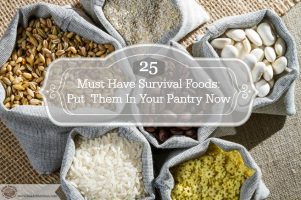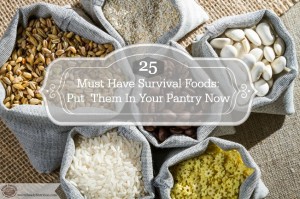One of my favorite phrases that I tell new preppers is that “your preps are your lifeline.” We must put measures in place before a disaster is upon us in order to have these lifelines available to us when we need it the most.
Building an emergency pantry is one of those lifelines that takes both time and planning to make it fully functional. Ideally, you want to store shelf stable foods that your family normally consumes, as well as find foods that are multi-dynamic and serve many purposes.
A few other points to consider when starting an emergency food pantry are:
- To store emergency foods that will not require refrigeration, and should require little electricity or fuel to prepare.
- The food should have a long shelf life.
- It should provide ample nutrition and contain little salt.
In my book, The Prepper’s Cookbook: 300 Recipes to Turn Your Emergency Food into Nutritious, Delicious, Life-Saving Meals, I use the following essential food staples as the basis for the recipes. The following foods are all popular food staples that should be considered as “must haves” for your emergency pantries. The advantages to storing these items, is they encompass all of the key consideration points listed above. Best of all, these items are very affordable and versatile, thus making them worthy of being on your storage shelves for extended emergencies.
Keep in mind, that water is your most important prep. You need water for consumption, food preparation, and for sanitary needs. Ensure that you have a large quantity of water stored away for emergency use.
Stock up on the following items today to get your prepper pantry ready for the next extended emergency:
1. Canned fruits, vegetables, meats, and soups
2. Dried legumes (beans, lentils, peas)
3. Crackers
4. Nuts
5. Pasta sauce
6. Peanut butter
7. Pasta
8. Flour (white, whole wheat)
9. Seasonings (vanilla, salt, pepper, paprika, cinnamon, pepper, taco seasoning, etc.)
10. Sugar
11. Bouillon cubes or granules (chicken, vegetable, beef)
12. Kitchen staples (baking soda, baking powder, yeast, vinegar)
13. Honey
14. Unsweetened cocoa powder
15. Jell-O or pudding mixes
16. Whole grains (barley, bulgur, cornmeal, couscous, oats, quinoa, rice, wheat berries)
17. Nonfat dried milk
18. Plant-based oil (corn oil, vegetable oil, coconut oil, olive oil)
19. Cereals
20. Seeds for eating and sprouting
21. Popcorn (not the microwavable kind)
22. Instant potato flakes
23. Packaged meals (macaroni and cheese, hamburger helper, Ramen noodles, etc.)
24. Purified drinking water
25. Fruit juices, teas, coffee, drink mixes
Use this list as a starting point on beginning or extending your preparedness pantry- and don’t feel handcuffed to only stocking up on these items. Always keep your family’s food preferences and dietary needs in mind when investing in your food supply. It would be extremely advantageous to have a two week supply (at a minimum) of these shelf stable food items on hand to care for your family. To see how much your family would need, click here.
We never know when disasters or emergencies may strike, so why not be prudent and be ready for them before they affect our livelihood and well being.
Tess Pennington is the author of The Prepper’s Blueprint, a comprehensive guide that uses real-life scenarios to help you prepare for any disaster. Because a crisis rarely stops with a triggering event the aftermath can spiral, having the capacity to cripple our normal ways of life. The well-rounded, multi-layered approach outlined in the Blueprint helps you make sense of a wide array of preparedness concepts through easily digestible action items and supply lists.
Tess is also the author of the highly rated Prepper’s Cookbook, which helps you to create a plan for stocking, organizing and maintaining a proper emergency food supply and includes over 300 recipes for nutritious, delicious, life-saving meals.
Visit her web site at ReadyNutrition.com for an extensive compilation of free information on preparedness, homesteading, and healthy living.
This information has been made available by Ready Nutrition


